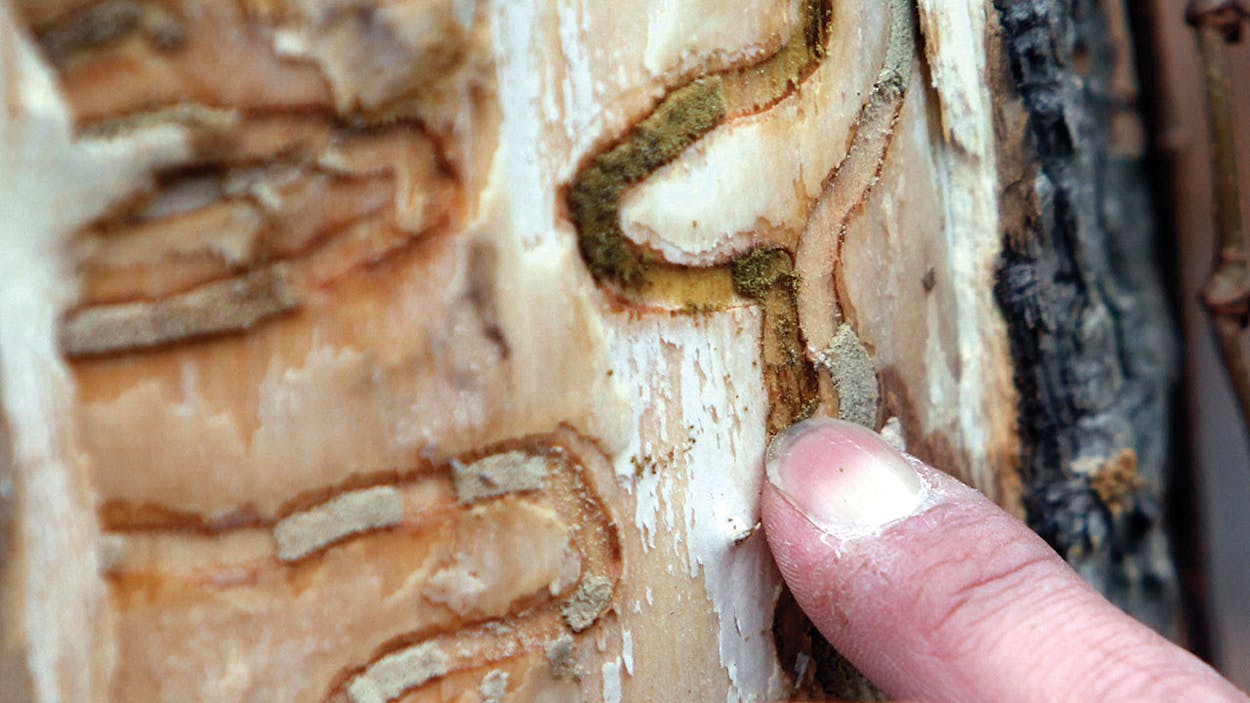One month into the invasion of Texas, Allen Smith was driving to the site he calls Ground Zero, six miles west of the Louisiana line. “Excuse the mess,” he said. “I’ve been living out of this truck since the discovery. It’s been a little bit crazy.”
Smith, an entomologist for the Texas A&M Forest Service, parked beside a farm-to-market road a few miles south of Karnack, in rural Harrison County. He waded through a weedy ditch, sidestepped a dog’s carcass, and came to the edge of a swampy forest. High overhead, in the upper boughs of an ash tree, a bug trap dangled like a green box kite.
“This is where the beetles were,” Smith said upon lowering the trap. “Don’t let it touch you. It’s really sticky.”
The beetles in question were not just any beetles. They were the dreaded emerald ash borers, so named for their metallic-green wings and their habit of boring into ash trees. On April 29 a Louisiana-based federal entomologist was checking this trap when he discovered four of them, the first time borers had been spotted in Texas. No one knows how long it will take the beetles to fully establish themselves here—years, probably—but they could eventually decimate 99 percent of Texas’s seven species of native ash, a toll of more than 400 million trees.
“We’re afraid we’re going to lose all our ash trees,” Smith said. “Like, extinct.”
In the borer’s native eastern Asia, birds and wasps keep it in check. But in the United States it has no major predators, leaving it free to go about its business, which it conducts by munching ash leaves and laying eggs in the crevices of ash bark. After the eggs hatch, their larvae burrow in maze-like tunnels that block the flow of nutrients and water, killing a tree within two to three years.
The borer has swept across 25 states since it first appeared in Michigan, in 2002, destroying hundreds of millions of trees. It showed up in southwestern Arkansas in 2014 and in northwestern Louisiana last year, so the Texas A&M Forest Service was on the lookout for its local debut. For the past five years, forest service employees have regularly checked for emerald ash borers across the state, though federal budget cuts and a dispute between Texas and the feds recently reduced the number of traps by half, to 420. Because the borers often hitch rides on lumber and firewood, the forest service can’t be sure where they will pop up next. “They may emerge in a totally different part of the state,” said Paul Johnson, Texas A&M Forest Service’s urban forestry coordinator.
Though Texas is best known for its pecan trees, live oaks, and pines, ash make up 4 percent of the trees in our forests. They’re a bit less common in urban settings, but arborists prize them for their height, shade, and abundant foliage; ash were popular replacements for elms wiped out by Dutch elm disease throughout much of the twentieth century. They make up more than half the canopy in some neighborhoods, particularly those where the homes were built from the late sixties through the early eighties.
“The emerald ash borer may not have a big impact overall on a community, but it could have a devastating impact on some neighborhoods,” Johnson said. When he moved to Austin two years ago, Johnson bought a home with a pair of Arizona ash trees growing in the front yard. “One of the first things we did was start planting other trees, so when we need to remove the ash, we already have trees started,” he said. Johnson thinks Austin will lose a million trees. Houston will lose millions. Hundreds of thousands are at risk in Dallas.
Not all hope is lost, though. Scientists are searching for ways to control the pests, including the introduction of north Asian non-stinging wasps, which eat the borer, and the Lady Bird Johnson Wildflower Center has collected 125,000 seeds from Texas ash trees to ensure the species’ survival even if the worst happens. In the meantime, as the beetles make their way across the state, landowners can inject their trees with multiple insecticides, which protect them for a few years.
Educating the public about the threat is a major priority for the forest service, though the process doesn’t always go smoothly. At a landowners’ meeting in May, one East Texan stood up and stated his belief that ISIS released the borers as part of a jihadist plot, a theory that Smith respectfully disputed. Very much to his surprise, however, Smith hasn’t found any sign of infestation in East Texas—not even in the tree at Ground Zero, which looks fine. But it’s only a matter of time. Unlike ISIS terrorists or federal military occupiers or whatever other bugaboos keep Texans locked and loaded, the emerald ash borer is really here. And the invasion is just beginning.









